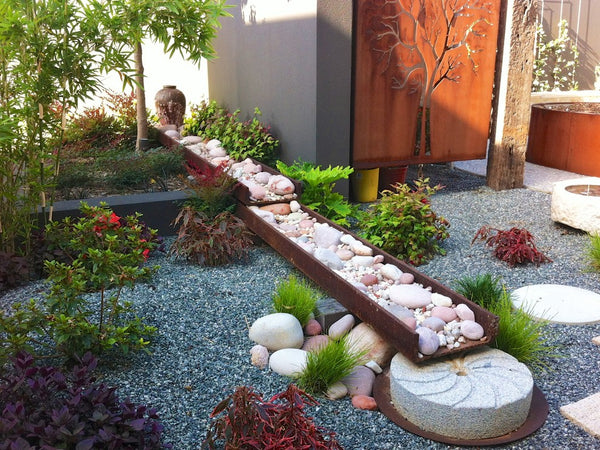

This design tip really is more food for thought that a definite rule, as I’d imagine that most people would prefer the inclusion of some flowers and scent in their garden. In Buddhist Japanese gardens, flowers would almost certainly be removed as these were considered a distraction to those Buddhists trying to clear their mind and keep a focus on the absence of thoughts. Some designers would argue that flowers should be removed from plants to keep the distraction to a minimum.

Flowers are not dominantįlowers can be used in Japanese Garden Design, but traditionally should only be used to highlight or complement the green colours in the garden. Man made tiles or shaped stones can be used, but again always make sure that it can be linked to the naturalistic setting and doesn’t become the main feature itself. Thoughtful use of materials and textures such as giving reference to pebbles found on coastlines or gravel that may be found on mountainous paths can help link the path to nature whilst helping navigate the visitor around the garden. It symbolises what lies ahead in life and helps give the visitor a quiet purpose in the garden to travel using the paths to explore what lies ahead. Using paths to take you to other parts of the garden is another essential feature of a Japanese garden. Whatever features, plants and landscaping you use must serve a purpose to reflect nature, bring zen and to encourage a state of introspection or meditation to the visitor. Which means you probably want to reconsider that LED rock light, which is neither natural of in keeping with the simplicity of zen. The devil is in the detail and each part of the garden should represent part of the theme, such as planting to symbolise nature, water for the ebb and flow of life or rocks to symbolise a mountain. One of the most important, and often overlooked, design features is that everything should serve a purpose in a Japanese zen garden. The main feel should be that of an evolved garden which flows rather than a brutal contemporary structure. Some straight lines can be used but more of a detail than an overarching structure. Curves and a flow to the garden are essential. So rectangular beds or square ponds don’t work within this brief. All the components of the garden should either represent or symbolise nature. It could be that this natural look is a contrived and stylised version of nature, the point is it should be easily interpreted as being a reflection of nature. This doesn’t necessarily mean it needs to look authentically natural. When planning your Japanese garden design it is worth whilst remembering that you’re trying to echo nature.

Careful planning is required which may lead to many ‘non-zen’ moments along the way! However, a stitch in time will soon lead to a beautiful distraction-free zen haven. For this design guide, zen would be something that’s effortless, calming and allows you to enter a state of mindfulness if they wish, such as meditation. Many zen experts would be ‘mindfully’ shouting at me, but this article is not trying to detail the merits or forms of zen. Japanese gardens are all about creating zen, but what exactly is zen? In its simplest form, it’s a state of meditation and intuitive thinking. Creating nature is the ultimate display fo control and power! They may feature stylised versions of Japans geography with miniature versions of waterfalls or rocks to symbolise mountains etc. Used by commanders in chief as a retreat during times of civil unrest or the revolutions that have taken place throughout Japans history. The gardens were signs of their wealth and used as places of refuge. Gardens as a sign of power, culture & wealth: The calming space found in Japanese gardens is more likely to have been adopted by the elite or ruling families that existed hundreds of years ago in Japan.Mimicking the style of nature and with minimal distractions allowing clarity to meditate on. Buddhist Origins: Japanese gardens are a place for peace, meditation and contemplation which is why they are frequently used by Buddhists and Buddhist monks.They can, however, be boiled down to two groups of influencers, which has led to two main designs and functions. Religion, the battle for dynasties and politics have all shaped Japanese gardens.
Modern zen garden ideas how to#
This will help you understand how to achieve a more coherent Japanese theme in your design. I mean who doesn’t? So I won’t be going into any real depth here apart from to differentiate between the two main influences that have shaped traditional Japanese gardens. Japan has a long and complicated history. Brief Background of Japanese Garden Design


 0 kommentar(er)
0 kommentar(er)
